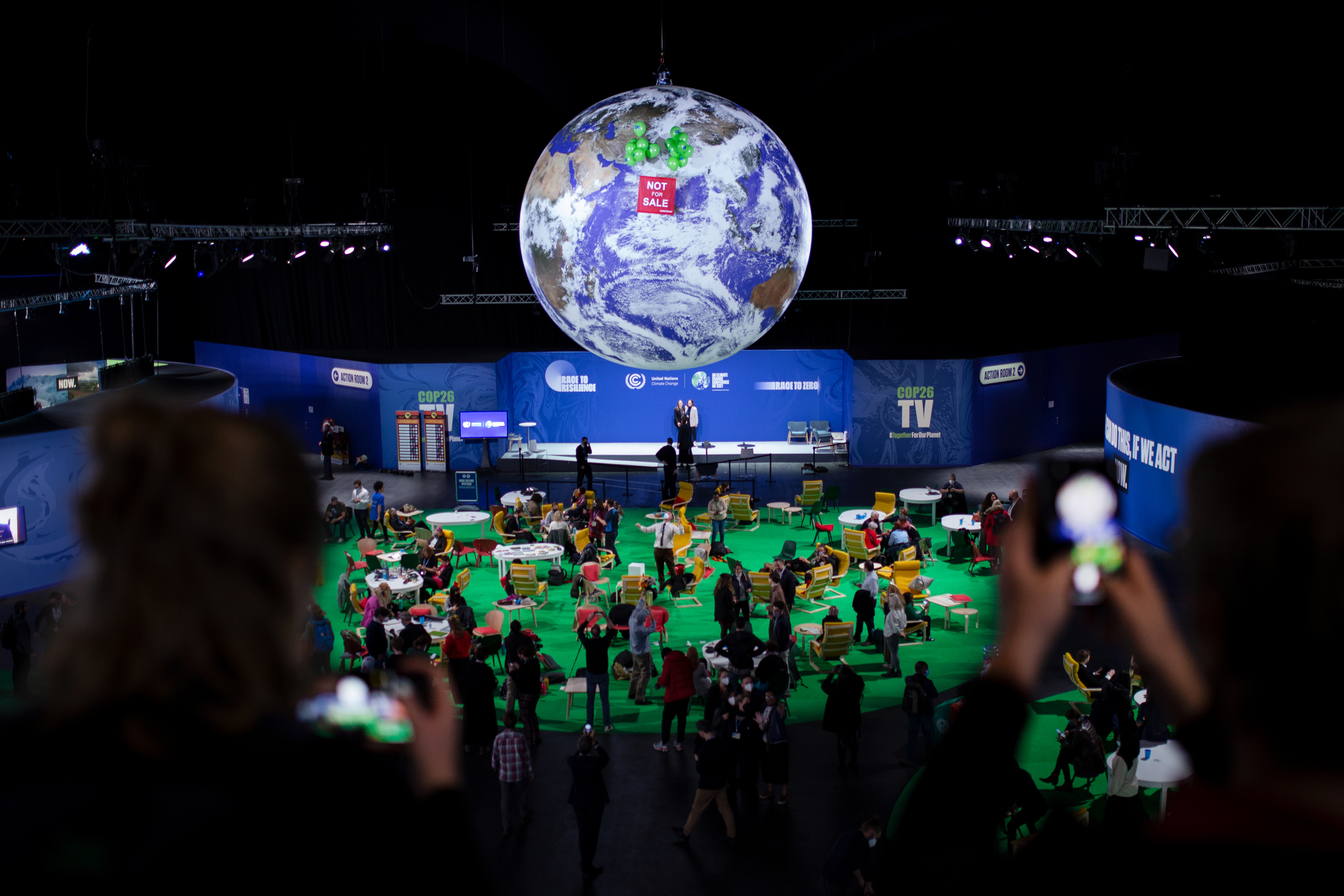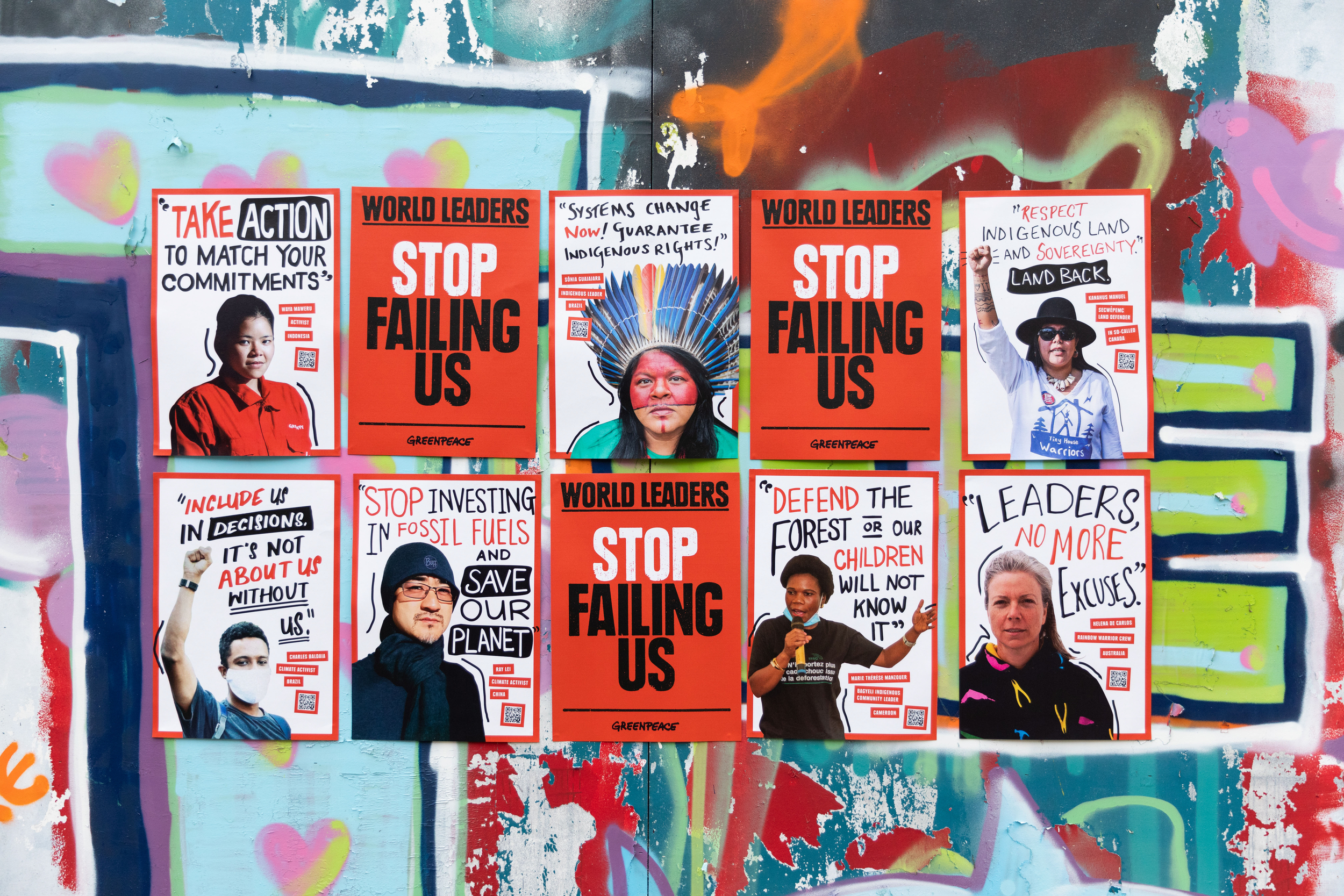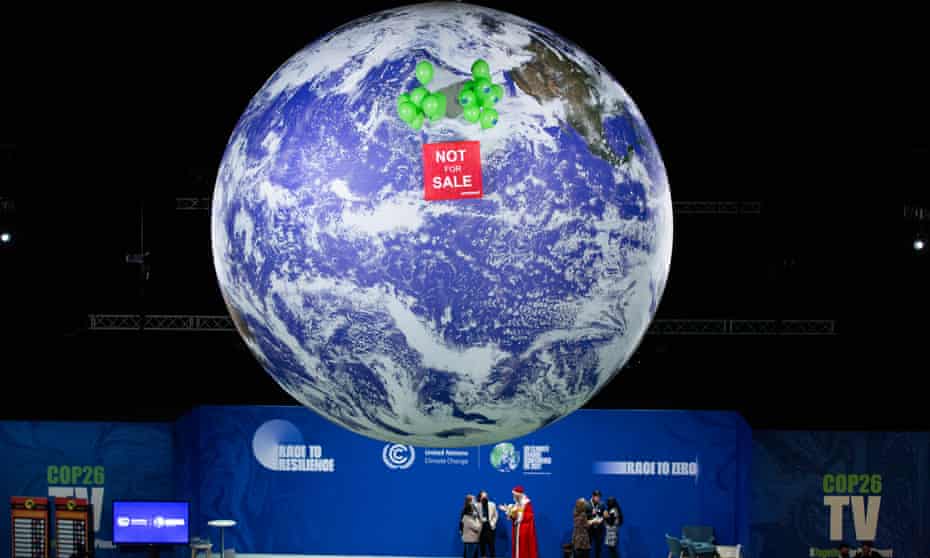If you want to know if something has succeeded, you should start by asking the people with the most to lose. In this case, that’s those who are already being hit hardest by climate change, and they’ve given a clear answer:
What
is balanced and pragmatic to other parties will not help the Maldives
adapt in time. For us, this is a matter of survival. We recognise the
foundations that this outcome provides, but it does not bring hope to
our hearts. The difference between 1.5 and 2 degrees is a death sentence
for us.
Shauna Aminath, minister of environment for The Maldives
The
climate emergency has already arrived in our territories. And we are
very worried about all these announcements, and deals that are being
signed here without considering or respecting the rights and
participation of Indigenous Peoples.
Sônia Guajajara, Brazilian Indigenous leader
I’m
hugely disappointed and hugely let down by COP. Coming from Chad,
millions of my people are suffering but nobody is listening to our
cries, our tears. It’s our planet, and it’s time to stop messing about
with our future.
Safia Hasan, 15, climate activist from Chad
These groups are suffering the most from climate change, even though they did nearly nothing to cause it. But their reasonable demands for help protecting themselves against climate impacts, and compensation from the damage it’s already done, were downplayed and sidelined in the talks.
And while the COP26 deal doesn’t put the 1.5C goal completely out of reach, the governments and companies that obstruct bold action on climate change are knowingly endangering whole communities and cultures for their own short-term profits or political convenience. History won’t judge them kindly for this.
It’s important to be honest about this situation. But it’s also important to remember how much we still have to fight for. There’s no single moment when it’s ‘too late’ to act on climate change; no cut-off point where we can’t choose a better path.
Every ray of hope and inch of progress at COP26 was won through relentless pressure from activists, campaigners and diplomats, especially those on the front lines of the crisis. It’s always been this way, and always will.
So for all the missed opportunities, it’s still worth asking: did COP26 make things better than they were before? Did it create some good foundations to build on? Or did it create new problems that will need to be untangled later?
What was decided at COP26?
Global climate talks have two main strands. You have the formal (and often technical) UN negotiations, which produce a final ‘decision text’ that every country signs.
Alongside that, you often have what’s essentially a giant trade show, where everyone who’s working on climate change comes to boast about what they’re doing. The UK government’s love of good green PR meant we saw even more of these shiny ‘side deals’ at this COP than normal.
This second strand can feel like a bit of a circus, but positive news here can build goodwill and momentum that feed into the formal negotiations.
Let’s run through the big decisions and announcements, starting with what was in the official agreement:
Climate justice
What happened? Governments wrangled over funding and wider support to help poorer countries protect themselves against climate impacts, and compensate them for loss and damage they suffer as a result of emissions from the rich world.
Verdict: you break it, you pay for it. Climate change is already putting a huge financial burden on poorer countries who did almost nothing to cause this crisis. Over a decade ago, governments promised $100bn a year, but they’re still not paying up in full.
There was a tiny bit of progress here, thanks to activists and delegates from climate-vulnerable countries piling on the pressure. But rich governments still didn’t go nearly far enough. While this huge injustice continues, it’ll be hard to build the trust we need for real progress.
A nail in the coffin for coal
What happened? It only took 26 years, but the world’s governments finally officially acknowledged that tackling climate change means moving away from one of the biggest causes of climate change. The final COP26 agreement explicitly talks about ‘phasing down’ coal-burning.
Verdict: bad for fossil fuels, but not bad enough. A major theme of COP26 was sending a signal to the wider world that fossil fuels are on their way out. Lots of the wrangling over the text was really about how strong that signal should be. And while fossil fuel execs certainly won’t be celebrating, the negotiations fell far short of the decisive ‘time’s up’ message we needed. As Greenpeace’s exec director Jennifer Morgan put it, COP26 was bad for fossil fuels, but not bad enough.
A better timetable for tougher targets
What happened? Countries’ existing climate targets aren’t anywhere near enough to keep temperature rises under 1.5 degrees. So they agreed to return with stronger targets in 2022, rather than leaving the normal five-year gap between new commitments.
Verdict: essential urgency. This tougher deadline will put pressure on countries to bring their targets into line with the 1.5C goal. It’s also more in line with the overall urgency of the climate crisis.
Carbon offsetting
What happened? A new official agreement paved the way for countries to trade emissions cuts, paying others – often in the Global South – to ‘offset’ the climate pollution they generate rather than reducing it directly.
Verdict: a license to pollute? COP26 opened the gates for much more carbon offsetting. This is almost certainly bad news, because carbon offsetting is almost certainly a colossal scam that will delay real action on climate change.
Many of the rules and safeguards that could have made the system even vaguely useful were left out, and the resulting loopholes put Indigenous Peoples at even more risk, as their lands will be in demand for new offsetting schemes.

Greenpeace activists raise a banner reading “NOT FOR SALE” against the iconic giant globe
at the centre of the COP26 conference hall in Glasgow, as talks enter their final hours.
© Emily Macinnes / Greenpeace
The side deals
Forests deal
What happened? Over 100 governments signed a voluntary side agreement that promised to end deforestation and protect indigenous rights.
Verdict: blah blah blah. There was no sign of actual policies to actually deliver on these promises, and there are major question marks surrounding the new funding. Greenpeace Brazil’s Carolina Pasquali said: “There’s a very good reason [Brazil’s forest-destroying president] Bolsonaro felt comfortable signing on to this new deal. It allows another decade of forest destruction and isn’t binding.”
And to top it all off, this deal looks suspiciously similar to another agreement from back in 2014, which did literally nothing to slow deforestation. World leaders have a long track record here, and it’s not good.
Fossil fuel funding
What happened? A group of over 20 governments and financial institutions agreed to stop funding new overseas fossil fuel projects with public money by the end of 2022. The group includes some major players in energy financing, including Canada, the US, and the UK. This was possibly the most important side agreement at COP26.
Verdict: beginning of the end. Historically, governments have been keen to invest in building fossil-fueled power plants outside their borders. But despite some technical loopholes, this agreement starts to bring that era to an end.
It’ll become much harder to build new dirty energy infrastructure, as companies will have to rely on private banks or domestic government funding. It’s vital that overseas energy funding is redirected into renewable projects instead, and that this ambition is extended to end all new fossil fuel projects immediately.
India’s net zero target
What happened? India pledged to reach ‘net zero’ emissions by 2070. The pledge was part of a new set of measures including a strengthened renewable energy target.
Verdict: better than expected. These measures move India’s climate policy more in the right direction, but there’s still a long way to go. The average person in India creates much less climate pollution than people in Europe or the US. But the size of its population means India’s government has huge influence over the climate. If they meet this goal, analysts say it’ll reduce global temperature rise by around 0.2C.
But 2070 is nearly half a century away, and the whole world needs to be ‘net zero’ by 2050 if we want to stay under 1.5 degrees. The next 10 years will be a good test of whether the government is taking climate change seriously. Greenpeace India’s Avinash Kumar Chanchal said the government “must start reducing emissions at source, as fast and as much as possible”.
Cutting methane
What happened? Over 100 countries joined a side pledge to slash methane 30% by 2030. Methane is a powerful greenhouse gas that mostly comes from rubbish dumps, industrial farms and leaky oil and gas wells. The pledge mainly focuses on the oil and gas element.
Verdict: not methane accomplished. There’s some good stuff here, but some big gaps too. The commitment failed to rule out new fossil fuels, and didn’t tackle industrial meat and dairy agriculture. Also, some of the world’s biggest emitters – including China, Russia and India haven’t signed up.
US-China deal
What happened? China and the US agreed to work together on ‘enhancing climate action’ through the 2020s, with collaboration on the technical nuts and bolts of cutting emissions.
Verdict: something to build on. Many feared that the terrible state of the US-China relationship could seriously hurt global carbon cutting efforts. So this step towards cooperation between the world’s two biggest emitters is a good sign. Their joint statement says a lot of the right things, but this won’t be a real breakthrough until they can back it up with some real actions.

Posters featuring portraits of climate impacted people and activists and their messages to world
leaders to tackle the climate and nature crisis. © Marie Jacquemin / Greenpeace
What does this all mean for global temperature rises?
You might have seen headlines talking about the world being headed for a particular amount of warming following the new pledges at COP26.
CAT global update: Glasgow has a credibility gap between talk and action. If all govts met their 2030 targets, we would have 2.4˚C of warming in 2100. But right now, current policies put us at 2.7˚C.

— ClimateActionTracker (@climateactiontr) November 9, 2021
There were a few different projections floating around, but importantly, they all see us going way past the 1.5 degree limit, beyond which some countries and regions will simply disappear from the map.
Where exactly we land mainly comes down to whether countries follow through on all their carbon-cutting commitments.
And that’s a big if. Given their track record on climate, it’s bold to assume countries like Australia and Saudi Arabia will reach net zero by 2050 simply because they’ve said they will – especially when their funding and policies to actually get there are seriously lacking.
It’ll be up to citizens, campaigners and forward-thinking politicians to make sure governments set more ambitious goals and stick to them. But until that happens, we should only trust those projections as much as we trust ultra-polluting governments to stop polluting.
What’s next for climate action globally?
The COP bandwagon rolls on, and the UK’s Alok Sharma is still COP president until next year. It’s up to him and the government to make sure countries build on the more positive things that were agreed in Glasgow, and patch up the holes in the agreement.
Rich countries’ reluctance to pay what they owe poor countries is also causing serious problems, slowing progress and undermining much-needed trust in the negotiations. Sharma needs to make this a priority – including getting the UK to make a more substantial contribution.
COP27 will happen in Egypt in 2022, with the UAE playing host the year after. As home to some of the world’s biggest oil producers and many of the countries most vulnerable to climate change, the Middle East will play a major part in deciding what happens to our climate.
But all the diplomatic wrangling won’t mean much if governments don’t actually stick to their climate commitments, and so far their track record isn’t exactly inspiring.
Delivering the actual emissions cuts to match the targets is a world away from the big-picture grandstanding at COP. It’s the work of imaginative civil servants and brave local councillors; committed businesses and active citizens. Success will be the sum of millions of good choices, supported by good government policies that make those choices possible.
And what’s next for climate action in the UK?
As the global spotlight shifts away from the UK after COP, there’s an immediate risk that the government will quietly green-light a bunch of high-carbon projects, including the Cambo oil field and Cumbria coal mine.
Beyond that, there are still some big gaps in the UK’s climate plans that need fixing. The government still hasn’t come up with enough money or policies needed to get the country’s emissions down in line with its targets. And they’re still not taking seriously the need for a just transition, which means ordinary workers in polluting industries risk losing out as we move to clean technology.
If you take away one thing from the story of COP26, please let it be this: there is power in our collective voice. There is a beacon of hope in the brilliant words and leadership of the four MAPA youth activists that sailed on the Rainbow Warrior to the steps of COP26. There is strength in the hundreds of thousands of people who took to the streets to protest in the rain. There is a guiding light from Indigenous Peoples, who have reminded us that failure is not an option.
I have been looking forward to reading the greenpeace report on COP26 and was not disappointed, as usual it is informative and to the point.
The blog song for today is: " Iron Man" by Black Sabbath
TTFN















